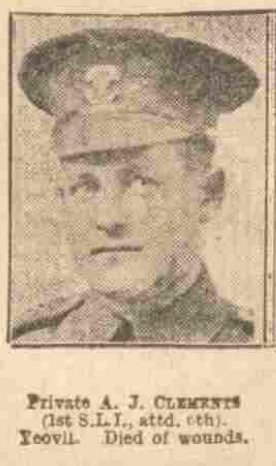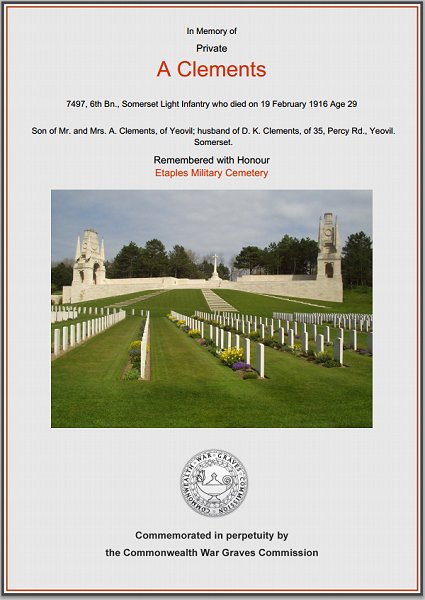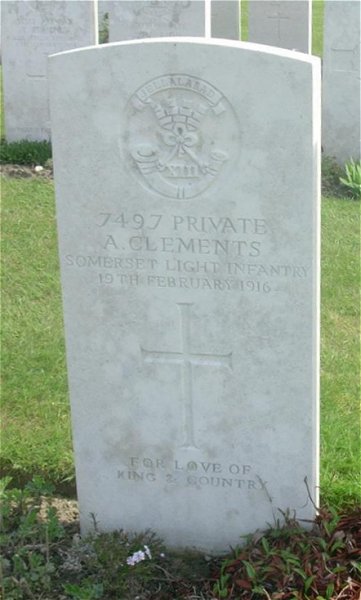yeovil at War
Arthur James Clements
Killed in action during the Somme Offensive
Arthur James Clements was born in Yeovil in the autumn of 1886. He was the eldest son of general labourer Albert Clements (b 1863) and Alice née Lintern (1865-1893) and in the 1891 census Albert and Alice were living at 4 Gold Croft with their children; Arthur, Mabel (b 1888), Alice (b 1889) and Lily (b 1891). By the time of the 1901 census the family had moved to 5 Reckleford Hill where Albert gave his occupation as brick maker and 14-year old Arthur listed his occupation as an errand boy. By this time Arthur had three younger brothers; Thomas (b 1891), Frank (b 1896) and Stanley (b 1898).
From his Service Number 7497 it appears that Arthur enlisted in the Regular Army at Yeovil during the autumn of 1904 when he was aged 18. He became a Private in the 1st Battalion, Prince Albert's (Somerset Light Infantry). The 1911 census lists him as a Private in barracks, unfortunately the barracks isn't named but was most likely at Taunton.
In the winter of 1912 Arthur married Dora Kate Evis at Yeovil. They were to have two children. Having served his nine year term of service he left the army and moved to Swindon where he worked for the Great Western Railway Company. It would appear that Arthur and Dora moved back to Yeovil and lived at 35 Percy Road.
 At
the outbreak of
war Albert, as a
Reservist, was
immediately
called up and
sent to France
with the 1st
Battalion,
Somerset Light
Infantry. Arthur
was wounded
towards the end
of 1914. After
making a
recovery he was
sent back to the
front line where
he was attached
to the 6th
Battalion of the
Somersets which
had arrived in
France on 21 May
1915.
At
the outbreak of
war Albert, as a
Reservist, was
immediately
called up and
sent to France
with the 1st
Battalion,
Somerset Light
Infantry. Arthur
was wounded
towards the end
of 1914. After
making a
recovery he was
sent back to the
front line where
he was attached
to the 6th
Battalion of the
Somersets which
had arrived in
France on 21 May
1915.
Arthur fought with the 6th Battalion throughout the latter part of 1915 and into 1916. Much of June 1915 was spent in the trenches to the east of Ypres where, although there were no pitched battles as such, the Battalion was under constant shell fire and rifle fire. For much of July the Battalion was employed in carrying supplies to the frontline trenches.
On 26 July 1915, while at Hooge, the Battalion was subjected to a new weapon of war - the flamethrower. This event is described in the Regimental History of the Somerset Light Infantry "Very early in the morning the front-line trenches of the Brigade were suddenly flooded by liquid fire, which belched from jets in the German lines opposite. This new device momentarily caused surprise and confusion, and the victims of this dastardly attack fell back from the front-line trenches which were then occupied by the enemy."
The rest of the year passed in day-to-day trench warfare with, as the Regimental History points out "Two days in and two days out of the front line was the rule at this period, but between the miserable conditions of the billets and the filthy state of the trenches there was little choice." Nevertheless the dangers of almost constant shelling from the enemy was an ever-present danger. The beginning of 1916 was relatively quiet for the 6th Battalion but, even so, Arthur was severely wounded in the head and died from his wounds at a base hospital on 19 February 1916. He was aged 29.
On 25 February 1916, the Western Gazette reported "News has been received in the town of the death from wounds of Private A J Clements of the 1st Somerset Light Infantry, attached 6th Battalion. Deceased was a Yeovilian, and his father at one time resided in Newtown. When War broke out he was working on the G.W.R. at Swindon, as was called up as a Reservist going to France with the 1st Battalion, Somersets. He was wounded two months later, but recovering was again sent to the Front, and attached to the 6th Battalion. Official information was received last week that he had been wounded in the head, and the news of his death at a base hospital came to hand a few days later."
Arthur Clements was interred at Etaples Military Cemetery, Pas-de-Calais, France, (Grave VI.C.8A), and his name is recorded on the War Memorial in the Borough.
gallery

Courtesy of Rob
Baker
Arthur Clements' photograph as published in the Western Gazette on 3 March 1916.

The Commonwealth War Graves Commission certificate in memory of Arthur Clements.

Arthur Clements' headstone.